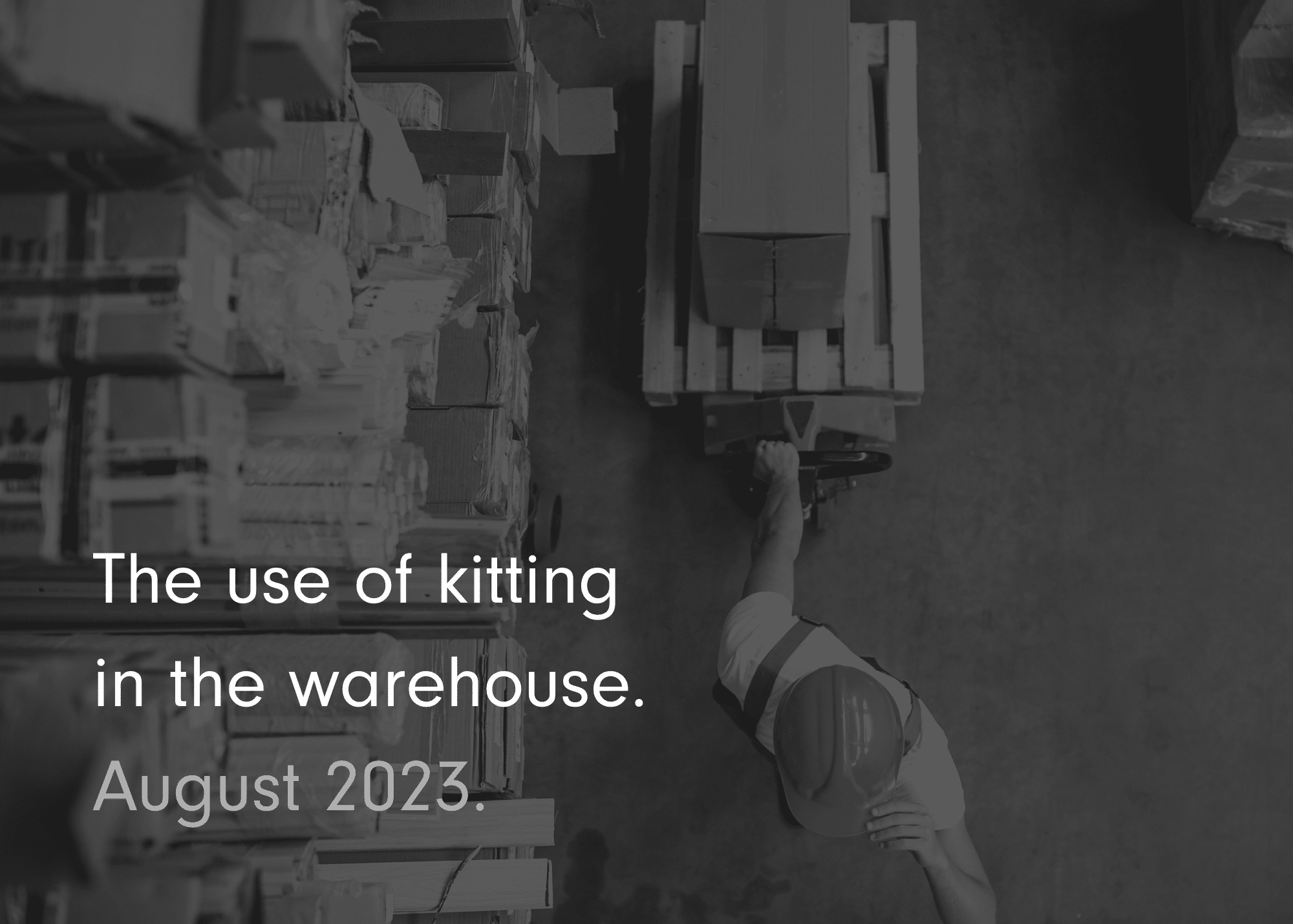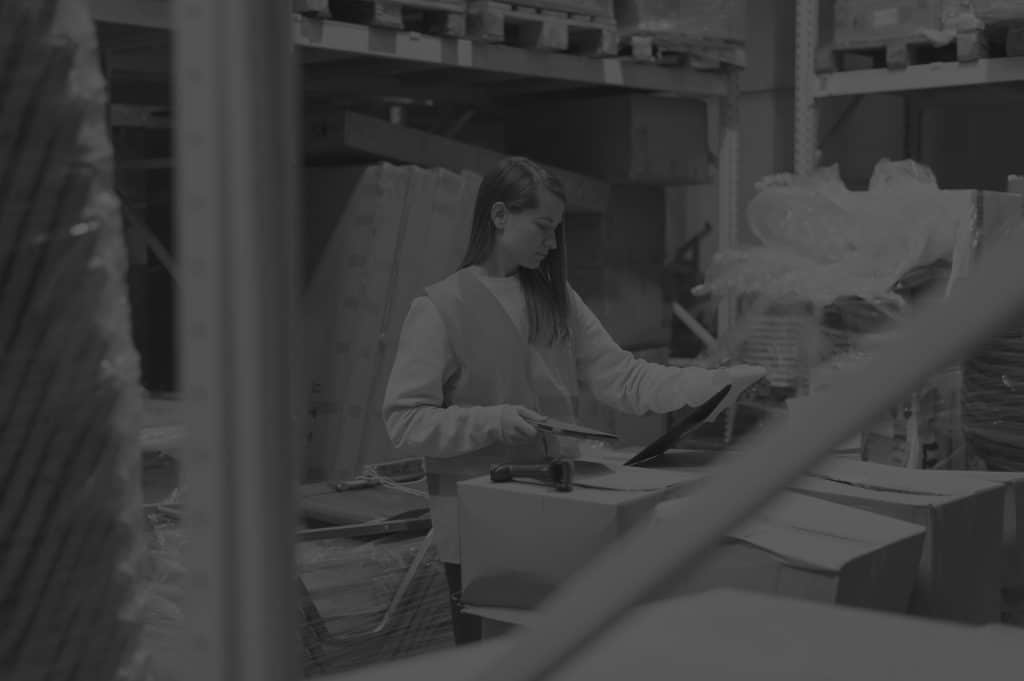Kitting in the warehouse

Distribution operations that offer customized product kits or bundled goods need efficient processes.
Managing warehouse kitting processes manually is challenging without a warehouse management system (WMS) to help. This method requires a lot of effort.
It also slows down your work. Additionally, it uses up valuable time and resources, allowing room for mistakes.
But with automated kitting, your warehouse can benefit from more streamlined operations, improved productivity and better customer satisfaction.
What is kitting?

Manufacturing environments first used this warehouse management strategy as part of the assembly process. It involves the advanced collection – or assembly – of several components to facilitate the construction of a finished item.
Assembling a circuit board, CPU, transistors, capacitors, memory, and connectors creates a computer motherboard.
In ecommerce warehouses, the process of kit creation follows the same pattern. Creating new products or bundles tailored for specific customers is crucial in warehouses with customizable items. This involves combining various components to form a unique entity. This process is particularly significant for businesses that offer personalized products or packages.
Some customizable bundles are effectively the ecommerce equivalent of “made to order” goods. Each customer gets a unique selection, so the kits can’t be pre-made because there are too many possible combinations.
You have 100 bottles of wine for sale. Customers can choose any 12 bottles to make a case. There are an incredible one quadrillion different ways to order the bottles. That’s a 1 followed by 15 zeros!
Warehouses with kitting operations often have over 100 SKUs, reaching numbers in the quintillions, sextillions, and beyond. And while these are already mind-boggling numbers, consider that this is the calculation where there are no duplicate items. When customers can order multiple products, the number of possible combinations becomes incredibly large and difficult to comprehend.
It’s impossible for a warehouse to have so many products ready as new SKUs, let alone pre-packaged and in stock. This adds vast complexity to a manual kitting process. However, using the functionality of a WMS makes things far simpler.
Applications of warehouse kitting.

Ecommerce environments utilize this process to offer bundles of products. Allowing your customers to assemble their own bundles can encourage the discovery of new products.
Another beneficial use of kitting is as a promotional tactic. You can create bundled offers, for example where customers buy any five products together and earn a 10% discount.
People often use kitting in situations where they can customize the constituent products, like a case of wine. Similarly, distributors of monthly subscription boxes and companies selling customizable hampers would need to follow this process.
It is also useful for subscription box operations where the product is not consistent for all customers. It is possible to offer different choices or customer preferences. For example, you can customize a beauty box for specific skin or hair types. Additionally, you can tailor a meal kit to your customers’ food preferences.
Allowing customers to tailor their purchases provides them with more flexibility. And when you have a wider choice of goods, the average order value tends to increase, too.
Kitting is also beneficial where you need to create small kits. A WMS kitting process efficiently selects and packages items together.
People use this process when they add batteries to toys or when they include free items with purchases. You may also choose to pre-package individual items that are commonly sold together to create a single kit. This reduces picking time, enabling faster order fulfilment.
Benefits of WMS-managed kitting in the warehouse.

Manually executing kitting poses many challenges. It can cause order delays, result in higher staffing costs and can compromise customer satisfaction. Without automation, you may have picking errors, stock discrepancies and difficulty locating items quickly.
Benefits of kitting by using a WMS- management system:
- Improved efficiency – by automating and guiding the process, you reduce errors, streamline workflows and increase productivity. Orders are fulfilled more quickly and your entire operation runs more efficiently.
- Enhanced accuracy – a WMS provides real-time visibility, ensuring you have accurate details about stock levels. This means you always know if the individual components that make up your kits are available and you can replenish items in good time, thus reducing your risk of going out of stock of something.
- Save money – by using a cloud-based WMS, you can lower costs and make more profit. This is because you can use your workers better and have less extra stock.
- A supply chain management system can handle different levels of complexity and volume, making it scalable for various kitting services. It can adjust to changes in capacity, like a seasonal increase, and help your growth without major system changes.
Best practices when implementing kitting in the warehouse.

If you don’t already use this system in the warehouse, you may want to consider it as a way of increasing sales. You could create promotions by bundling items together.
It may be that a promotional offer will help shift some slow-moving stock if you can bundle it with more popular items. Or you may be able to encourage volume sales by bundling three products together where perhaps two are usually sold together. You can also use assembled kits as a way to introduce customers to non-related products.
Once you know which products you want to offer as kits, you need to carefully design the workflows and processes needed. Where possible, you should establish standardized procedures for kitting operations so that you can ensure consistency and efficiency. Clearly define the steps involved, including the picking, manufacturing process, any quality control checks and the packaging. Your processes should be clearly documented so that you can train your warehouse staff and ensure everyone follows the same guidelines.
Your warehouse layout will likely benefit from reorganization so that it fits your kitting operation. Your design will need to minimize walking distances and maximise accessibility to items that are frequently picked into kits. By organising your stock in a logical manner, you can ensure that the kit components are easily identifiable and readily available. Consider implementing visual cues, such as labelling systems or colour-coding that will help workers quickly identify and retrieve the right items.
It’s imperative with kitting operations to maintain accurate stock management protocols. With several products making up a kit, if one item is out of stock, you cannot fulfil any orders for it. So, you need to ensure your records are accurate and up to date in order to prevent costly stockouts and to enable the replenishment of all the component items in good time. By implementing regular cycle counting, you can verify stock levels, improve accuracy and identify any discrepancies.
If possible, standardise your packaging so that it is uniform and consistent. This helps with picking efficiency as your staff only need to use a single type of packing, regardless of the make-up of the order. You should choose packaging that fits all the possible components but which also minimises wasted space and keeps shipping costs to a minimum.
You should clearly label the outer packaging with the product names, descriptions, part numbers and any other relevant information. Your staff can then easily identify items, which prevents mistakes and confusion.
Efficient SKU management will help with accurate tracking and effective stock control in your kitting operations. Assigning unique SKUs to each kit enables precise tracking and stock management of the individual components.
You will need to maintain comprehensive documentation of your SKUs and be prepared to update it regularly to reflect any changes in kits, their components and packaging.
Kitting using the Körber WMS Assembly module.

Using a WMS with kitting functionality can help automate and streamline your kitting. The Körber WMS Assembly module has kitting features that can facilitate and streamline your kitting processes.
The module takes the multiple component SKUS and combines them into one. It sets the workflows for your kitting processes and guides workers through them, ensuring your order fulfilment is accomplished quickly and accurately.
Using the Assembly module, the WMS maintains an inventory of all your kit components and tracks the availability, location and quantity of each. If you have any predefined kits, you can pre-assemble all the component items into a new, pickable SKU. The WMS sets out specific bills of materials (BOM) for the kits, specifying the individual components and their quantities, as well as providing any associated instructions.
When it comes to order management, the Assembly module identifies orders that require kitting, retrieves the associated BOM and then triggers the work order for the picking process. Staff are directed to pick the required components. They are given the location details for each item and any assembly instructions.
The individual SKUs are assembled into a new SKU. When all the items are collated together, this SKU can be scanned as picked at the packing area, which then updates the order status. A label can be generated at this point, detailing the product number, order number and a unique batch number.
Körber WMS tracks the movement of both the individual components and finished kits within the warehouse. This makes it easy to locate specific kits and monitor their progress and provides visibility and traceability across the whole assembly process.
If needed, you can incorporate quality control checks that are undertaken during the kitting process. You may want your workers to be prompted to perform inspections or checks at certain stages of the order fulfilment process to ensure correct packing or to ensure that the final product meets your quality control standards.
Kitting for streamlined warehouse operations.

Implementing a WMS for kitting can revolutionise your warehouse efficiency and enhance your entire supply chain operation.
The Körber WMS Assembly module is a comprehensive solution for managing the complex processes that are involved in assembling customised kits within your warehouse. By eliminating manual processes, reducing picking times and minimising errors, it streamlines your operation, ensuring better customer satisfaction.